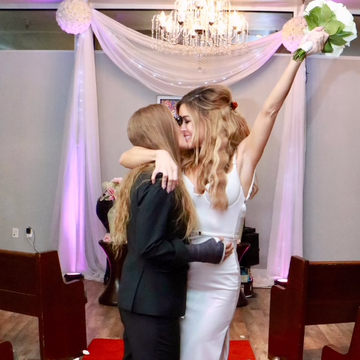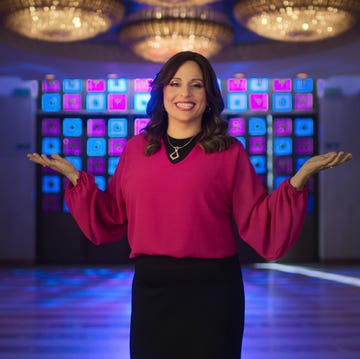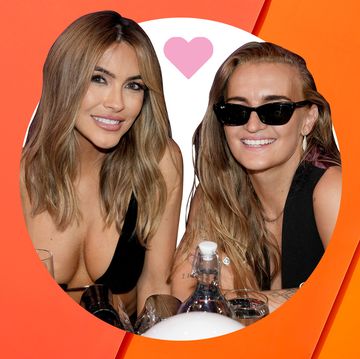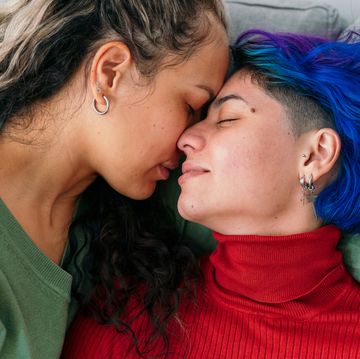There's a chance you landed here because you may not totally get all the terms and phrases to express gender identity.
“It's understandable that some folks may feel confused or even uncomfortable with all the variations of gender, gender identities, and gender roles,” says Tracy Marsh, PhD, faculty member for Walden University's PhD in Clinical Psychology program, and a licensed psychologist in California who specializes in LGBTQIA issues. Or, you could be exploring your own gender identity and looking for the right words to express yourself and help others understand.
Thankfully, it’s 2022, and many of the terms surrounding gender are becoming more widely recognized in our society. "The language we have around [gender identity] is rapidly expanding to accommodate for the wide variety of gender identities and expressions out there," says Paula Leech, LMFT, an AASECT-certified sex therapist. "The more we can expose ourselves to the diversity of gender identity and expression out in the world, the more likely we are to find ourselves reflected back with greater clarity."
And if you aren't sure about something, the best thing you can do is try to educate yourself. "Reach out and have a respectful dialogue with someone who has more knowledge of these terms and topics. Ask others how they identify and how they prefer to be addressed,” Marsh says.
Meet the experts: Tracy Marsh, PhD, is a faculty member for Walden University's PhD in Clinical Psychology program, and a licensed psychologist in California who specializes in LGBTQIA issues. Paula Leech, LMFT, is an AASECT-certified sex therapist. Jackie Golob, MS, works at a private practice at the Centre for Sexual Wellness in Minnesota
Women's Health spoke to experts on those questions you may want to ask, but don't know exactly where to start: What exactly does gender identity mean? What is biological sex vs. gender? And how do gender identity and sexuality relate? First, Jackie Golob, MS, who works at a private practice at the Centre for Sexual Wellness in Minnesota, provides an overview on some commonly confused ideas surrounding gender identity.
- Genitalia does not equal gender. “The sex characteristics a person is born with do not signify a person's gender identity. When people have ‘gender reveal parties,’ it really should be called a ‘genital reveal party,’” she offers. The concept of gender is a social construct, adds Golob.
- Forget about the two-gender binary. “Gender is a term that relates to how we feel about ourselves, the way we choose to express our gender through makeup, dresses, high heels, athletic shorts, sneakers, and more,” she explains. Our society has convinced us that there are just two options for gender identity, "male" and "female," based on biological sex. But in reality, there's more fluidity.
- Gender identity is on a continuum. It’s not just the male/female gender binary—there's a spectrum of gender identity. “[Most people] lie in between [the binary], with personality traits that relate to gender identity, expression, and biological sex. Gender identity can change over time, and it is not fixed,” says Golob. Just because you identify one way at one point in time, does not mean you will always choose that identity, or that your identity won't shift and evolve.
- Sexuality and gender identity are not the same thing. “Gender identity is how you feel about yourself and the ways you express your gender and biological sex,” says Golob. Meanwhile, sexuality refers to who you are emotionally, physically, romantically, or sexually attracted to, she says. In summary, “gender is how you feel about yourself, while sexuality is how you feel about others,” says Golob.
Now that you have the basics, let’s do a deep dive into gender identity terms and what they each mean.
1. Anatomical sex
In conversations about gender, you may hear this expression used. “Gender identity is about one's psychological sense of self. Anatomical sex is comprised of things like genitals, chromosomes, hormones, body hair, and more,” says Sophie Mona Pagès, relationship expert and founder of LVRSNFRNDS, a social network that fosters connections and conversations about relationships.
“You may be familiar with the terms ‘AFAB’ (Assigned Female At Birth) and ‘AMAB ’(Assigned Male At Birth). This is what they are about.” AFAB and AMAB people may not choose to identify with those terms during childhood, or when they become adolescents or adults.
2. Cisgender
This term describes a person whose gender identity aligns with or matches their assigned sex at birth. “If a doctor assigns gender based on genitalia, when the baby is born and says, ‘It's a girl,’ and that person aligns with their gender, that's what it means to be cisgender,” says Golob, noting that this term sometimes gets shortened to “Cis.”
3. Transgender
“Transgender people are folks whose gender identity does not match their sex assigned at birth. They can be trans men, trans women, and also non-binary people, meaning they do not identify as men or women,” says Pagès.
She adds one quick note: “Do not say ‘a trans’ or ‘a transgender.’ Say instead, ‘a trans person,’ ‘a transgender person,’ ‘a trans man,’ or ‘a trans woman.’”
4. Cishet
“Cishet refers to people whose gender identity and biological sex are aligned (cisgender), and who are sexually attracted to the opposite sex,” says Marsh. For instance, an individual born with a vagina who identifies as female and is romantically involved with males would be described as Cishet.
5. Non-binary
“Non-binary describes a person who does not identify clearly or exclusively as male or a female, says Alexandra Bausic, M.D., a board-certified OBGYN, and sex educator at Let’s Talk Sex. “They can either feel both gender characteristics or feel different from them.” You may hear non-binary used as an umbrella term for various groups of people that don’t identify as male or female.
6. Intersex
A person born with either some combination of both biological sex characteristics (genital organs, hormones, chromosomes) or certain genital variations that don't align with either biological sex is intersex, explains Bausic. “It is a natural variation in human anatomy, and it shouldn’t be perceived as something bad,” she says. Also, it's important to know that being intersex is not uncommon: Planned Parenthood estimates that one to two people out of every 100 in the U.S. are intersex.
Bausic adds that some examples of modified anatomic features of intersex people include a clitoris that’s larger than the average, a penis that is smaller than the average, or a closed vagina.
7. Genderqueer
“Genderqueer people can identify as neither woman nor man, both woman and man, or a combination of these genders,” says Pagès. Sometimes the words “genderqueer” and “non-binary” are used interchangeably.
“Genderqueer is often an identity that is also a political statement, and sometimes perceived as a third gender,” adds Marsh.
8. Gender-fluid
Just like you can be fluid in your sexual orientation of who you’re attracted to, you can also be flexible with your gender. “Gender-fluid typically refers to someone who prefers to express either or both maleness or femaleness, and that can vary, perhaps from day to day,” says Marsh.
“Some people's gender identity varies over time,” adds Pagès, who also recommends looking at the Genderbread Person, a helpful resource on understanding gender, as well as guidelines on explaining gender to others. FYI: The fluid (i.e., transformative) aspect of being gender-fluid can happen at any point in life. You can be super young or a supercentenarian—it doesn’t only occur during a particular time in your lifespan.
9. Gender Non-conforming
“Gender non-conformity refers to when someone does not conform to their cultural gender norms,” says Marsh. It could be something as minute as an Assigned Male At Birth (AMAB) person wearing nail polish, Marsh explains. That could be considered gender non-conforming, since nail polish is typically attributed to female-presenting people in our society. Or, on a larger scale, the person might not choose to identify with "he/him" or "she/her" pronouns.
Since all the specifics of these phrases may start to feel similar, Marsh provides some more useful intel: “The terms gender non-conforming, genderqueer, gender-fluid, and non-binary typically fall under the umbrella of transgender, or those persons who do not identify as cisgender,” says Marsh. But they don't all mean the exact same thing, so it's still important to check in with people to see what labels they prefer.
10. Gender-Expansive
You may have heard of “gender non-conforming,” but the phrase “gender-expansive” is coming to be the preferred choice among LGTBQIA+ people.
“Gender non-conforming was a term previously used, that still shows up in research and articles today, insinuating something is 'wrong' with a person if they are participating in something in society that is 'non-conforming' of the norm,” says Golob. Essentially, this term is cis-normative, she points out. “Gender-expansive is the term to use instead that allows folks creativity and freedom to not fit into a societal norm,” Golob says.
11. Agender
“Agender means that one does not identify with any gender,” says Marsh. “They do not feel a sense of male or female,” adds Marsh, noting that like other non-cisgender groups, they may ask to be addressed using the pronouns "they" or "them" rather than "he" or "she."
Golob elaborates that “Agender can also mean being gender-free, gender-blank, or genderless,” with no connection to any gender in particular.
12. Gendervoid
“Gendervoid is a term that is similar to agender, but specifically refers to not only a lack of gender identity, but also a sense of loss or a void in not feeling that gender identity,” explains Marsh. For gendervoid people, they feel like they don’t experience or aren’t able to feel their gender.
It may be helpful to remember, in short, that “biological sex is physical, while gender is feeling,” as Golob puts it. There's no pop quiz on these terms, we promise, but becoming familiar with all gender identities is part of being a thoughtful human, no matter where you fall on the gender spectrum.
13. Bigender
Not to be confused with bisexual, being bigender means "having two gender identities that can be experienced and expressed separately, or that can blend and be experienced simultaneously," says Leech. "Two gender identities can mean identifying as a man and woman, but it can also mean identifying as a man or woman and gender-neutral or agender."
14. Omnigender
"Someone who is omnigender identifies with all genders, each gender being experienced as separate with distinct qualities and characteristics," explains Leech. "People who identify as omnigender are often gender-fluid, moving amongst the genders depending on what feels authentic to who they are at a given moment or period in time."
15. Pangender
According to Leech, omnigender and pangender are sometimes used interchangeably, but there are a few key differences between the two. "Someone who is pangender identifies with, experiences, and 'is' all genders at once," she says. "All genders exist alongside one another simultaneously."
16. Two-spirit
This term is used by some Indigenous communities to refer to someone who "identifies as having a third gender, encompassing both a masculine and feminine spirit or essence," Leech explains, adding that non-Indigenous people should not use this term.
Perri is a New York City-born and -based writer; she holds a bachelor’s in psychology from Columbia University and is also a culinary school graduate of the plant-based Natural Gourmet Institute, which is now the Natural Gourmet Center at the Institute of Culinary Education. Her work has appeared in the New York Post, Men's Journal, Rolling Stone, Oprah Daily, Insider.com, Architectural Digest, Southern Living, and more. She's probably seen Dave Matthews Band in your hometown, and she'll never turn down a bloody mary. Learn more at VeganWhenSober.com.












